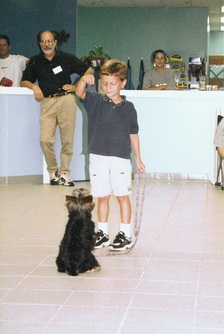Training Methods - Positive Motivation Builds Positive Behavior
|
C&C PALS teaches people what really motivates their dogs' behavior and debunks the many myths surrounding traditional training methods that have unwittingly led to behavioral problems in man's best friend. Classes work on teaching dogs good, basic household manners. Classes teach all the basic obedience commands, but, more importantly, they help pet dog owners understand how to get their pets to carry out the commands when asked in real-life situations. Socialization is another central part of classes, which is vitally important to help ensure the animal is friendly, thoroughly enjoys the company of people and knows how to act around other animals. This is often overlooked in other training styles and classes.
In all classes, the owners are taught how animals communicate and how they learn. Then owners use this knowledge to train their animals. So owners walk away from the classes not only knowing how to train their dogs, but also knowing why the training works! This is the new generation of dog training based on years of study of animal learning theory by scientists such as B.F. Skinner, Edward Thorndike and Ivan Pavlov and then applied to various animals by renowned behaviorists and trainers, such as Karen Pryor, Ian Dunbar, Jean Donaldson and Pamela Reid. |
These experts discovered that there are two basic ways animals learn: operant and classical. Operant learning occurs when you are training your dog to sit or come to you or not jump. In other words, the dog is "operating" on his environment. Classical learning refers to associative learning. It is the associations that a dog makes between things (for example, training your dog to like having his nails clipped or like having people around him while he is eating). Unfortunately, classical learning is often not addressed in many other training classes. Both of these are addressed in our classes, as not only are they both important, they are being learned simultaneously. This gives owners a broader understanding of their dogs' behavior and a well-rounded training program for their pets.
All training is done using a positive, motivational approach. To teach a behavior, lures are used to initially obtain the behavior and when desired behavior occurs, it is rewarded. A bridge word or sound (clicker) is used to mark the behavior and to signal the dog that a reward is coming. The dog then connects the word or sound with the reward. To stop unwanted behavior, the dog is "punished" by having something the dog likes removed from him. There is no use of force or coercion. All training is humane, with a gentle and effective approach that not only is fun and positive for both humans and dogs alike, but also enables all members of the family, including children, to train effectively.
All training is done using a positive, motivational approach. To teach a behavior, lures are used to initially obtain the behavior and when desired behavior occurs, it is rewarded. A bridge word or sound (clicker) is used to mark the behavior and to signal the dog that a reward is coming. The dog then connects the word or sound with the reward. To stop unwanted behavior, the dog is "punished" by having something the dog likes removed from him. There is no use of force or coercion. All training is humane, with a gentle and effective approach that not only is fun and positive for both humans and dogs alike, but also enables all members of the family, including children, to train effectively.


